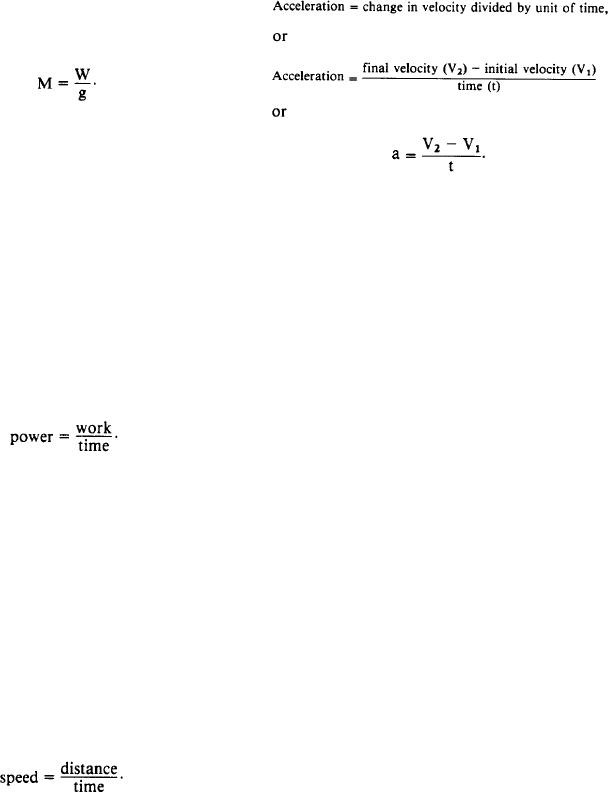
pounds on earth weighs 32 pounds on the moon
time. Negative acceleration is commonly called
because of the difference in the pull of gravity.
deceleration.
Yet the mass of the person is exactly the same.
A mathematical formula for mass is as follows:
Mass is equal to the weight of the object divided
by the acceleration due to gravity, or
Slug is an English measurement of mass. A
slug is mass with force and acceleration (due to
gravity) taken into consideration. So, a 1-pound
slug is the mass accelerated by 32 feet per second
per second (32 ft/sec2) when acted upon by a force
Acceleration due to gravity is 32.2 feet per second
of 1 pound.
per second (or feet per second squared).
This means that a free-falling 1-pound object
Energy is the capacity for doing work.
accelerates at 32.2 feet per second each second that
gravity acts on it. We use the lower case g to
Work is done when a force moves a mass
express the acceleration due to gravity.
through a distance (work = force x distance). For
Standard day is a reference or standard.
example, if you raise a 100-pound weight 10 feet,
Standard day shows conditions at sea level:
1,000 foot pounds of work was done. The amount
barometric pressure--29.92 inches of mercury
of work is the same, regardless of how much time
(Hg); temperature--59.0F.
(rate) is involved.
All gas turbine engines are rated with air at
Power is the rate of doing work, or
the standard temperature of 59F. Operation of
engines at a temperature above or below this
temperature will proportionally affect thrust out-
put by as much as 15 or 20 percent. As the
temperature of a slug of air increases, the
In the above example, if the work was done
molecules move faster. They run into each other
with more impact, and move further apart. This
in 10 seconds, power expended was 100 foot
decreases the density of the air. With the decrease
pounds per second. If it took 5 minutes (300
in density, the weight of the air is less, and the
seconds), the rate of power is 3.3 foot pounds per
thrust produced is proportional to the weight of
second. We often talk of power in terms of
the slug of air.
Pressure effect is an increase in pressure,
Horsepower is the English measurement for
resulting in more molecules per cubic foot, which,
mechanical power and is 33,000 foot pounds per
in turn, increases the weight of the slug of air.
minute, or 550 foot pounds per second. (Foot
The weight of the air affects thrust output.
pound is the energy required to lift a 1-pound
Ram effect is defined simply as more air
weight 1 foot in height.)
arriving at the engine intake than the engine can
ingest. Ram recovery is the airspeed at which ram
Speed is the distance a body in motion travels
pressure rise is equal to friction pressure loss. This
per unit of time. Expressed in terms like miles per
speed varies with duct design factors. Mach 0.2,
hour (MPH) and feet per second.
or 150 miles per hour, is a representative reference
number for the beginning of ram effect.
Now let's apply the terms we learned to the
principles of thrust.
Velocity is speed in a given direction. The
symbol V represents the term velocity.
NEWTON'S LAWS OF MOTION
Acceleration (a) is the rate of velocity change.
Newton's first law states "A body (mass) at
This definition is not based on distance traveled.
rest tends to remain at rest, and a body in motion
Acceleration is the gain or loss of velocity with
1-6

